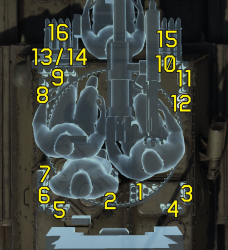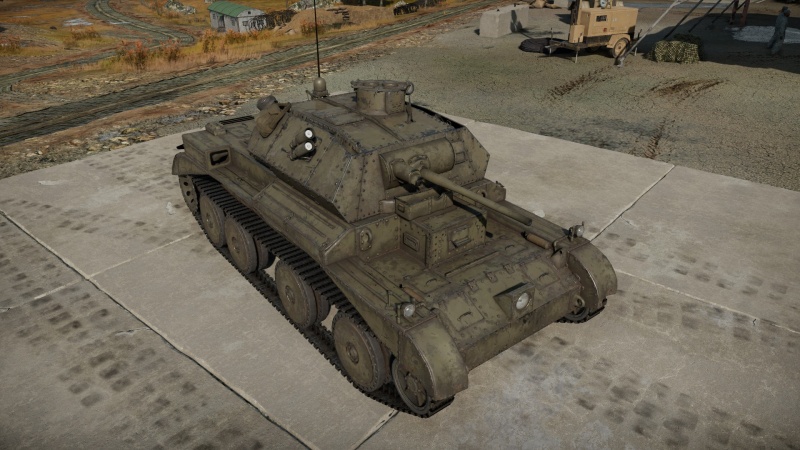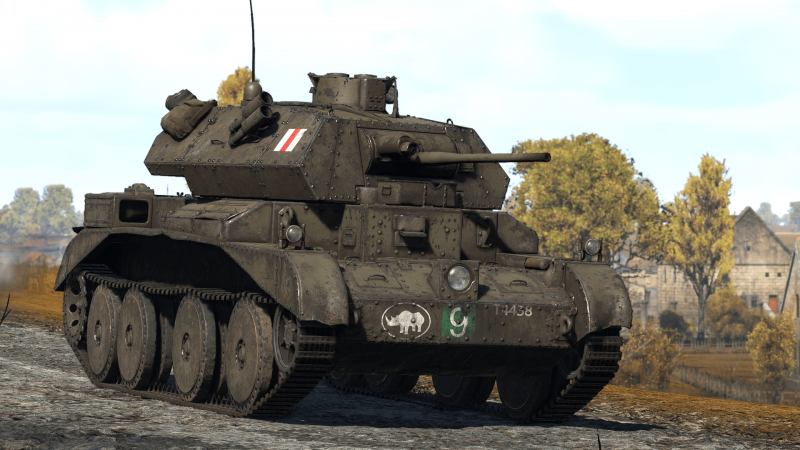A13 Mk II
| This page is about the British light tank A13 Mk II. For other versions, see A13 (Family). |
Contents
Description
The Tank, Cruiser, Mark IVA (A13 Mark II) is the late-production second variant of the A13 cruiser tank family. In contrast to the early-production variant, which was simply an A13 Mark I with increased turret armour, the A13 Mark II, also known as A13 Mark IIA, was produced with extra hull armour. The tank was utilized in France in 1940 and in the early stages of the war in North Africa before being retired. It was perhaps the greatest light tank Britain had in 1940, as it was a speedy vehicle compared to other British tanks of the early part of the war. There were 955 of these tanks produced in all.
Introduced in Update 1.55 "Royal Armour", the A13 Mark II offers small upgrades over the A13 Mark I, most notably in armour protection. However, the armour modifications in the A13 Mark II still do not provide much protection against anything other than heavy machine gun fire. The 40 mm Ordnance QF 2-pounder tank gun is adequate for its rank, capable of dealing with the majority of the adversaries it would encounter. However, the ammunition lacks the penetrating power and accuracy required to cope with stronger adversaries at long ranges.
General info
Survivability and armour
Armour type:
- Rolled homogeneous armour
- Cast homogeneous armour (Gun mantlet)
| Armour | Front | Sides | Rear | Roof |
|---|---|---|---|---|
| Hull | 30 mm Front plate 14 mm (62°) Upper glacis 30 mm Front glacis 14 mm (64°) Lower glacis |
7 + 7 mm | 14 mm (0-62°) | 14 mm |
| Turret | 14 mm (0-15°) Turret front 14 mm (1-63°) Gun mantlet |
14 (40°) + 14 mm (21°) | 14 (21-30°) + 14 mm (2°) | 14 mm |
| Cupola | 14 mm | 14 mm | 14 mm | 14 mm |
Notes:
- Suspension wheels and tracks are 15 mm thick.
- There is a 14 mm thick firewall between the engine bay and the crew compartment.
Mobility
| Game Mode | Max Speed (km/h) | Weight (tons) | Engine power (horsepower) | Power-to-weight ratio (hp/ton) | |||
|---|---|---|---|---|---|---|---|
| Forward | Reverse | Stock | Upgraded | Stock | Upgraded | ||
| Arcade | Expression error: Unexpected * operator. | 527 | Expression error: Unexpected round operator. | __.__ | |||
| Realistic | 301 | Expression error: Unexpected round operator. | __.__ | ||||
Even though the A13 has good mobility, it sometimes feels weird: it loses speed on turns, does not accelerates quite as fast as it's overpowered engine(38.19 HP/ton, stock) should provide it and hill-climbing feels hard. All of these flaws come from the gearbox, which has bad and uneven ratios, resulting in a kick when changing speed. Knowing that you should always keep an eye on the "gear" counter top-left of your screen (activate it in the options menu) since it provides you crucial information on how your tank will react to your commands. With a bit of practice, one should swiftly masters these peculiarities.
Modifications and economy
Armaments
Main armament
Since the QF 2-pounder is used on most tanks of Rank I, it's important to know it well. This cannon has a major disadvantage at distances since its rounds lose around 20 mm of penetration for every 500 m it travels, which is a lot. As if this was not enough, it has poor accuracy, even with Adjustment of fire, hence, one should target large components (crewmen, engine, transmission), of the enemy or, as distance increases (500 m or more), the general centre of the foe. Firing it, you will easily notice its last but not least flaw: it does almost no post-penetration damage, which means you will need to snipe crew members, one by one. Combine this difficulty with a bit of distance and this task can prove tricky pretty quick, sometimes leaving the enemy enough time to replenish its crew before you finish it off.
On the other hand, this cannon has 5 major advantages: reload speed, close-quarter penetration, a primitive stabilizing system, LOTS of ammo and awesome gun depression. Its fast reloading speed allows it to compensate its poor accuracy: missed a shot? why not take another even before you can reposition! Close quarter penetration, one of the best at its tier, is also a plus: your enemies will only block you shot if you happen to hit a steep-angled plate of armour. Does this tank have good mobility? nice !, it can fire on the move too, at low speeds and on the relatively flat road though but still, it is much more precise than the comparable BT-7 with its 20-K. Last but not least, small bullets means more bullets: the A13 can bring up to 87 bullets into the game, much more than you need to knock out 3-4 tanks, which means you can try to suppress an enemy and keep it into cover by constantly firing near it (at this rank, this tactic can prove effective against new players). Finally, its good gun depression enables it to fire over hills, peeking only it's a small turret, shooting and disappearing swiftly. Use these features cunningly.
| 40 mm QF 2-pounder | Turret rotation speed (°/s) | Reloading rate (seconds) | |||||||||||
|---|---|---|---|---|---|---|---|---|---|---|---|---|---|
| Mode | Capacity | Vertical | Horizontal | Stabilizer | Stock | Upgraded | Full | Expert | Aced | Stock | Full | Expert | Aced |
| Arcade | 87 | -15°/+20° | ±180° | Shoulder | 34.3 | 47.4 | 57.6 | 63.7 | 67.8 | 3.64 | 3.22 | 2.97 | 2.80 |
| Realistic | 21.4 | 25.2 | 30.6 | 33.8 | 36.0 | ||||||||
Ammunition
| Penetration statistics | |||||||
|---|---|---|---|---|---|---|---|
| Ammunition | Type of warhead |
Penetration @ 0° Angle of Attack (mm) | |||||
| 10 m | 100 m | 500 m | 1,000 m | 1,500 m | 2,000 m | ||
| Shot Mk.1 AP/T | AP | 72 | 68 | 52 | 37 | 27 | 19 |
| Shot Mk.IXB APCBC/T | APCBC | 89 | 86 | 77 | 66 | 57 | 50 |
| Shot Mk.1 APHV/T | AP | 80 | 75 | 58 | 41 | 30 | 21 |
| Shell Mk.1 AP/T | APHE | 66 | 62 | 49 | 36 | 26 | 20 |
| Shell details | ||||||||||||
|---|---|---|---|---|---|---|---|---|---|---|---|---|
| Ammunition | Type of warhead |
Velocity (m/s) |
Projectile mass (kg) |
Fuse delay (m) |
Fuse sensitivity (mm) |
Explosive mass (TNT equivalent) (g) |
Ricochet | |||||
| 0% | 50% | 100% | ||||||||||
| Shot Mk.1 AP/T | AP | 792 | 1.08 | - | - | - | 47° | 60° | 65° | |||
| Shot Mk.IXB APCBC/T | APCBC | 792 | 1.24 | - | - | - | 48° | 63° | 71° | |||
| Shot Mk.1 APHV/T | AP | 853 | 1.08 | - | - | - | 47° | 60° | 65° | |||
| Shell Mk.1 AP/T | APHE | 792 | 1.08 | 1.2 | 9 | 20.9 | 47° | 60° | 65° | |||
Ammo racks

| Full ammo |
1st rack empty |
2nd rack empty |
3rd rack empty |
4th rack empty |
5th rack empty |
6th rack empty |
7th rack empty |
8th rack empty |
|---|---|---|---|---|---|---|---|---|
| 87 | 78 (+9) | 75 (+12) | 72 (+15) | 69 (+18) | 66 (+21) | 62 (+25) | 60 (+27) | 56 (+31) |
| 9th rack empty |
10th rack empty |
11th rack empty |
12th rack empty |
13th rack empty |
14th rack empty |
15th rack empty |
16th rack empty |
Visual discrepancy |
| 51 (+36) | 47 (+40) | 43 (+44) | 41 (+46) | 36 (+51) | 31 (+56) | 16 (+71) | 1 (+86) | No |
Note:
- Centre hull empty: 41 (+46) shells.
Optics
| A13 Mk II Optics | ||
|---|---|---|
| Which ones | Default magnification | Maximum magnification |
| Main Gun optics | x1.85 | x3.5 |
| Comparable optics | AMR.35 ZT3 | |
Machine guns
| 7.7 mm Vickers | ||||
|---|---|---|---|---|
| Mount | Capacity (Belt) | Fire rate | Vertical | Horizontal |
| Coaxial | 3,500 (250) | 390 | - | - |
Usage in battles
The A13 Mk II is a Cruiser tank and plays very much like one. The relative lack of armour and high mobility allow the A13 to easily flank the enemy team. While the armour upgrades in the Mk II do not help against much more than heavy machine gun rounds, the A13 still has its speed as its biggest advantage. The 2 pounder main armament is an excellent weapon, and allows the A13 to engage effectively at any range. Generally the Shell Mk.1 AP/T (APHE) round should be used, as it has the largest post-penetration effect, however for tougher foes the solid AP rounds will easily penetrate. A13 commanders should use cover and try to outmanoeuvre opponents, engaging whenever they see fit.
Some notable enemies the A13 might face are German Panzer II tanks. These vehicles have autocannons that will shred through the A13's armour. Commanders should be extra cautious when facing these. Generally it is advisable to try and bait out their volley with a quick push forward and retreat, and then try to take them out while they reload. The A13 is at a disadvantage against these vehicles, its only real advantage being the fact that the 40 mm 2 pounder is shoulder stabilized, meaning it is easier to get the first shot off when slowing down.
Since the addition of smoke in War Thunder, light tanks have it easier. Use your forward-launching smoke to create a wall of smoke in a strategic place. It can be used to cover your allies, when capturing a point, flanking in a street (urban environment),
Pros and cons
Pros:
- Decent fast-firing gun against common foes like Pz.III
- Fast and agile thanks to good HP/ton ratio
- Has a shoulder stabilisation; advantage in CQC
- Add-on armor on turret, effective against small caliber AP shells
- Has forward-launching smoke launchers
- -15° gun depression allows it to fight in the most uneven terrains
Cons:
- Thin armour all round, can be penetrated by any cannon
- Poor reverse speed, can sometimes be fatal
- Loses speed when traversing the hull
- Wiggles when trying to turn on 5th gear
History
Development
The British development on their cruiser tanks advanced greatly with the implementation of the Christie suspension system, which they acquired from an American firm. The tank underwent a development program under the name Cruiser Mk III (A13) and the first accepted variant for the military was the A13 Mk.I. The Mk.I featured 15 mm of armour, a 2-pounder cannon, and a Vickers machine gun as its coaxial armament. An order of 65 of these tanks were asked for in 1939 at the Nuffield Mechanization & Auto Limited, but only 30 were made before the a decision was made to upgrade the existing model with more armour and different armament.
The redesigned cruiser tank, the A13 Mk.II, Cruiser Tank Mk IV, had a new armour thickness of 30 mm and additional sloping armour was put onto the sides and rear of the turret. The Vickers machine gun used as the coaxial armament was also replaced by the BESA machine gun, a licensed Czech ZB-53 machine gun, due to issues with the Vickers gun. Around 225 to 665 A13 Mk.II tanks were produced from 1940 until late 1941.
Combat Usage
The A13 first saw combat in the Battle of France under the British Expeditionary Force in 1940. The A13 encountered many trouble during its employment, the crew have little to no training with the new tanks due to their rushed adoption into service, the tanks were in poor condition and some were even missing parts. The A13s were used in the 1st Armoured Division, but many were either destroyed by the superior German armoured forces or abandoned at Calais during the evacuation of Allied troops at Dunkirk, which forced the units to leave behind their heavier equipment.
After the disaster at France, the A13 were still used to support the war. Some were sent to Greece to support their defense against Germany in the Battle of Greece, but a majority were sent to North Africa as part of the Western Desert Campaign near Libya under the 7th Armoured Division. Compared to the time in France, the A13s in North Africa fared much better, ironing out most of its initial defects, and was even more suited to the environment than other tank designs. The A13 was popular with the crew for its high speed, reliability, and a powerful 2-pounder cannon that could engage a majority of Axis tanks in 1941. However, there was an insufficient number of A13s available for use, so tank units were mixed with the faster cruiser tanks and slower infantry tanks, which caused tactical and logistical difficulties trying to accommodate all of the tanks. Another deficiency with the tank and every other British tank with the 2-pounder was the lack of high-explosive shell issued to the tankers, which made them vulnerable to anti-tank guns, which caused a majority of British tank losses in the North African Campaign. Still, the A13 fared very well with its armour and armament until the late 1941 where better armoured Panzer IIIs and Panzer IVs began to appear on the battlefield.
Due to its growing obsolescence on the battlefield, the A13 was replaced in 1941 by the better armoured A15 Crusader tank.
Media
- Skins
- Videos
See also
Links to the articles on the War Thunder Wiki that you think will be useful for the reader, for example:
- reference to the series of the vehicles;
- links to approximate analogues of other nations and research trees.
External links
Paste links to sources and external resources, such as:
- topic on the official game forum;
- other literature.
| Nuffield Mechanizations and Aero Limited | |
|---|---|
| Cruiser Tanks | |
| Tank, Cruiser, Mk III (A13 Mk I) | A13 Mk I · A13 Mk I (3rd R.T.R.) |
| Tank, Cruiser, Mk IV (A13 Mk II) | A13 Mk II · A13 Mk II 1939 |
| Tank, Cruiser, Mk VI, Crusader (A15) | Crusader II · Crusader "The Saint" · Crusader III |
| Tank Destroyers | Tortoise |
| SPAAs | Crusader AA Mk I · Crusader AA Mk II |
| Export | ▄Crusader Mk.II |
| Britain light tanks | |
|---|---|
| A13 | A13 Mk I · A13 Mk I (3rd R.T.R.) · A13 Mk II · A13 Mk II 1939 |
| A15 | Crusader II · Crusader "The Saint" · Crusader III |
| A17 | Tetrarch I |
| IFV | Warrior · Desert Warrior (Kuwait) |
| Wheeled | Daimler Mk II · AEC Mk II · Fox · Vickers Mk.11 |
| Other | VFM5 |
| South Africa | |
| SARC | SARC MkIVa · SARC MkVI (2pdr) · SARC MkVI (6pdr) |
| Ratel | Ratel 90 · Ratel 20 |
| Rooikat | Rooikat Mk.1D · Rooikat 105 · Rooikat MTTD |
| Other | Concept 3 · Eland 90 Mk.7 |
| USA | Stuart I · Stuart III |






